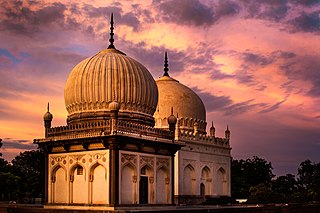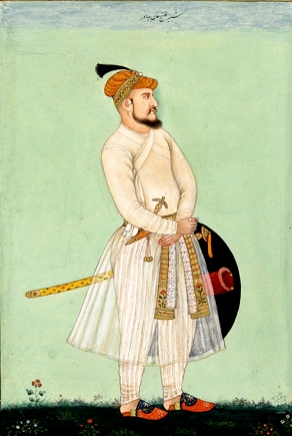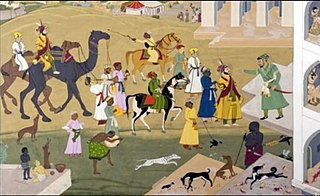
The Deccan Sultanates were five late-medieval Indian kingdoms—on the Deccan Plateau between the Krishna River and the Vindhya Range—that were ruled by Muslim dynasties: namely Ahmadnagar, Berar, Bidar, Bijapur, and Golconda. The sultanates had become independent during the break-up of the Bahmani Sultanate. The five sultanates owed their existence to the declaration of independence of Ahmadnagar in 1490, followed by Bijapur and Berar in the same year. Golconda became independent in 1518, and Bidar in 1528.

The Qutb Shahi dynasty was a Persianate Shia Islamic dynasty of Turkoman origin that ruled the Sultanate of Golkonda in southern India. After the collapse of the Bahmani Sultanate, the Qutb Shahi dynasty was established in 1512 AD by Sultan-Quli Qutb-ul-Mulk, better known though less correctly referred to in English as "Quli Qutb Shah".

Abdullah Qutb Shah was the seventh ruler of the kingdom of Golconda in southern India under the Qutb Shahi dynasty. He ruled from 1626 to 1672.

Abul Hasan Qutb Shah, also known as Abul Hasan Tana Shah was the eighth and last ruler of the Qutb Shahi dynasty, sovereign of the Kingdom of Golconda in South India. He ruled from 1672 to 1686. The last Sultan of this Sunni Islamic dynasty, Tana Shah is remembered as an inclusive ruler. Instead of appointing only Muslims as ministers, he appointed Brahmin Hindus such as Madanna and Akkanna brothers as ministers in charge of tax collection and exchequer. Towards the end of his reign, one of his Muslim generals defected to the Mughal Empire, who then complained to Aurangzeb about the rising power of the Hindus as ministers in his Golconda Sultanate. Aurangzeb sent a regiment led by his son, who beheaded Tana Shah's Hindu ministers and plundered the Sultanate. In 1687, Aurangzeb ordered an arrest of Tana Shah, who was then imprisoned at the Daulatabad Fort. He died in prison in 1699.

Golconda is a fortified citadel and ruined city located in the western outskirts of Hyderabad, Telangana, India. The fort was originally built by Kakatiya ruler Pratāparudra in the 11th century out of mud walls. It was ceded to the Bahmani Kings by Deo Rai, Rajah of Warangal during the reign of Sultan Muhammad Shah of the Bahmani Sultanate. Following the death of Sultan Mahmood Shah, the Sultanate disintegrated and Sultan Quli, who had been appointed as the Governor of Hyderabad by the Bahmani Kings, fortified city and made it the capital of the Golconda Sultanate. Because of the vicinity of diamond mines, especially Kollur Mine, Golconda flourished as a trade centre of large diamonds known as Golconda Diamonds. Golconda fort is currently abandoned and in ruins. The complex was put by UNESCO on its "tentative list" to become a World Heritage Site in 2014, with others in the region, under the name Monuments and Forts of the Deccan Sultanate.

The Qutub Shahi Tombs are located in the Ibrahim Bagh, close to the famous Golconda Fort in Hyderabad, India. They contain the tombs and mosques built by the various kings of the Qutub Shahi dynasty. The galleries of the smaller tombs are of a single storey while the larger ones are two storied. In the centre of each tomb is a sarcophagus which overlies the actual burial vault in a crypt below. The domes were originally overlaid with blue and green tiles, of which only a few pieces now remain.

The Asaf Jahi was a Muslim dynasty that ruled the Hyderabad State. The family came to India in the late 17th century and became employees of the Mughal Empire. They were great patrons of Persian culture, language, and literature, and the family found ready patronage.
Toli chowki is a neighbourhood in Hyderabad, Telangana, India. The name Tolichowki comes from the Urdu word 'Toli', meaning 'troupe', and 'Chowki', meaning 'post'. It is close to the IT corridor like Gachibowli, Madhapur, Manikonda and Kondapur, hence making it a preferred residential for people working in the IT industry. The real estate sector has received a boost due to its proximity to high-end technology firms. Tolichowki has also had a boost in the restaurant and fast food industry. It is known to attract many customers from all around due to having multi-cuisine meals all around the area. There has been an emergence of Arab cuisine in the area due to Middle Eastern people's moving in the area for medical or academic purposes. This in return has improved Tolichowki's market value for foreigners

Khawaja Abid Khan Siddiqi, or Nawab Khawaja Abid Siddiqi, better known as Kilich Khan, was a Nawab and military general under Mughal Emperor Aurangzeb. He was a loyal general of the Mughal Empire. He was the father of the Mughal general Ghazi ud-Din Khan Feroze Jung I and the grandfather of Mir Qamar-ud-din Siddiqi, Asaf Jah I.

Mir Shihab-ud-Din Siddiqi, known by his title Ghaziuddin Khan, was a leading military general and noble of Central Asian origin in the Mughal Empire. He was a favoured member of emperor Aurangzeb's court, and the father of Chin Qilich Khan, founder of Hyderabad State. Under Aurangzeb, he distinguished himself in key battles over the Deccan, and held the governorship of Berar Subah. He briefly served as the governor of Mughal Gujarat during the reign of Aurangzeb's successor Bahadur Shah, and died in office. He is buried in a madrasa complex he founded during his lifetime, known as Madrasa Ghaziuddin Khan, which is located in Old Delhi.

Naya Qila is an extended portion of Golkonda Fort in Hyderabad, India. It was built in 1656 by Sultan Abdullah Qutb Shah as further defence for the Mughal armies. This integral part of the Golkonda fort contains many historic structures. There are strange figures and animals worked out of stone and stucco on the walls of the outer fort facing the Naya Qila. It is one of the least explored heritage sites of India, partly because it has become part of a golf course, which makes access for visitors complicated.

The siege of Bijapur began in March 1685 and ended in September 1686 with a Mughal victory. The siege began when Aurangzeb dispatched his son, Muhammad Azam Shah, with a force of nearly 50,000 men to capture Bijapur Fort and defeat Sikandar Adil Shah, the then ruler of Bijapur, who refused to be a vassal of the Mughal Empire. The siege of Bijapur was among the longest military engagements of the Mughals, lasting more than 15 months until Aurangzeb personally arrived to organize a victory.

Muqarrab Khan of Golconda, also known as Khan Zaman Fath Jang Dakhini, was an Indian Deccani Muslim, who was the most experienced commander of Qutb Shahi Dynasty, during the reign of Abul Hasan Qutb Shah. He is known for betraying Abul Hasan Qutb Shah during Siege of Golconda. He arrested Maratha Emperor Sambhaji at Sangameshwar.
During the final Siege of Wagingera, the Mughal Emperor Aurangzeb sent for Zulfiqar Khan Nusrat Jung who arrived on March 27, and the next day attacked Lal Tikri Hillock which was lost to the Ramoshis in the early days of the siege and retook it. The Ramoshis retreated to the village at the foot of Talwargera and began operating from behind its mud wall. Many Rajputs fell in this daring attack. But Zulfiqar Khan Nusrat Jung did not stop there. He sent Rao Dalpat Bundela to another mound which was taken and the Ramoshis fled to the village of Dhedpura, where he was ambushed. But Zulfiqar Khan Nusrat Jung held his position. A few days afterwards Zulfiqar Khan Nusrat Jung made a strategic move and captured the wells from where the Ramoshis used to draw their water. He attacked Talwargera on April 27 taking the village.
Hyderabad was the capital of the Indian states of Telangana and Andhra Pradesh. It is a historic city noted for its many monuments, temples, mosques and bazaars. A multitude of influences has shaped the character of the city in the last 400 years.

The history of Telangana, located on the high Deccan Plateau, includes its being ruled by the Satavahana Dynasty, the Kakatiya Dynasty (1083–1323), the Musunuri Nayaks (1326–1356), the Delhi Sultanate, the Bahmani Sultanate (1347–1512), Golconda Sultanate (1512–1687) and Asaf Jahi dynasty (1724-1950).
Mubariz Khan was the Mughal governor of Gujarat and Hyderabad Subah. He was the governor of Golconda from 1713 to 1724 until he was killed during the Battle of Shakar Kheda where he fought against Nizam-ul-Mulk, Asaf Jah I. His is known to have ruled Golconda with a free hand and brought it under stable rule from constant Maratha Raids to extract Chauth. He is generally described as a proto-dynastic figure by John F. Richards.

Khwaja Sabir, Nasiri Khan or Khan-i-Dauran was an Indian Muslim viceroy of the Deccan and one of the Mughal emperor Shah Jahan’s leading sardars. He received the title "Khan Dauran" during the conquest of Daulatabad. He died in Lahore in 1645 from a knife wound from his own attendant, a Kashmiri Muslim. He hald the rank of 7,000 horse.

Asad Khan, born Muhammad Ibrahim, was a high-ranking noble of the Mughal Empire during the reigns of Aurangzeb and Bahadur Shah. He is known for his tenure as the wazir of emperor Aurangzeb in the period 1676–1707, and was an important player in Mughal court politics.
Hyderabad Subah, also known as Golconda Subah, was a province of the Mughal Empire encompassing the eastern Deccan region of the Indian subcontinent. It was created in 1687, during the reign of Mughal emperor Aurangzeb, by the annexation of the Golconda Sultanate. It later began to secede in the 18th century as the Mughal Empire declined, and became fully independent as part of the Nizam-administered Deccan.
















